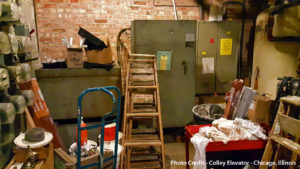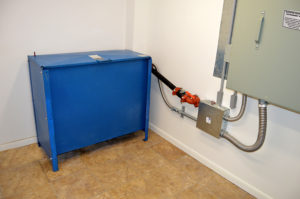Snake Bit
May 16, 2017Benefits MRL
June 12, 2017It’s a Machine Room, Not a Broom Closet

There is an old joke that the long in the tooth elevator folks repeat to the new guys. If they happen to make the mistake by saying an elevator has just one stop, the rookie will inevitably hear, “It’s an elevator, not a broom closet.” The veteran will be quick to point out that every elevator has at least two stops or it simply will be a broom closet with expensive doors. Unfortunately, they don’t have a similar joke about the machine room with the punchline being “It’s a machine room – not a broom closet.” Ba dum tshh.
Clutter is Contagious
Machine rooms don’t start out being a catch-all, but the open space is a tempting sight for everyone in a crowded building. The result is that some building owners or managers see lots of real estate in a machine room that is going unused, and they lick their chops with envy and desire to fill that void with all kinds of stuff. Just as often, it is well-meaning employees seeking a place to dump items they want to get out of their way. Lastly, the machine room can become a hiding place and lounge for refuge-seeking smokers on winter days and those looking for a quiet place to take a coffee break.
As a result, machine rooms often become a repository for cleaning materials, flammable liquids, brooms, buckets, mops, ladders, boxes piled to the ceiling, files and filing cabinets, banker boxes, rags, light bulbs, chairs, Christmas ornaments, newspapers, cigarette butts, books, magazines and old candy wrappers. You get the point.
Candy Wrappers to Flammable Liquids
But the machine room is not a break room, storage area or broom closet, and the American Society of Mechanical Engineers (ASME) code for elevators makes it clear that the space needs to be left open and safe.
ASME is the American National Standard for elevators, or the Bible as far as elevator requirements are concerned. The current national standard states there must be a minimum of 18 inches to access the tank, or power unit, and 36″ clear in front of electrical components. Furthermore, nothing is allowed in the machine room that is not elevator-related.
Simply put, buckets and mops don’t help the elevator run smoothly any more than flammable materials like paint and industrial strength cleaning fluids affect the elevator speed. So they aren’t allowed in the machine room.

What a machine room should look like.
Close the Door
The machine room door must also be self-closing and self-locking. This ensures that only properly trained elevator mechanics will enter it, and it won’t be a break room for employees hiding from the boss or the boss hiding from the employees.
Why so picky? For good reason. Untrained people could inadvertently damage equipment, or come into contact with high voltage. Flammable materials could combust and start a fire, damaging the equipment. So the machine room needs to be emptied of all the extraneous items that might have found their way into the room, and non-elevator people need to stay out.
Follow the Code – It is More than a Guideline
Lastly, each state may have additional requirements, which may exceed the national code. Massachusetts, for instance, requires 24 inches on two sides of the power unit in the machine room. Michigan requires that the machine room door be within 10 feet of the hoistway. But none of them permit storing furniture and janitorial supplies.
You may be losing a broom closet, but you will be gaining peace of mind knowing that your machine room and all of its components are safe and sound!



